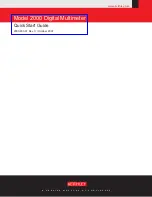
Cardiac Functions
Arrhythmia Functions
2
2-19
Table 2-13. Numeric Codes for Multiple-PVC Settings
Multiple-PVC Setting
Numeric Code
PAIR PVCs
027
RUN 5 PVCs
028
RUN 11 PVCs
029
Ventricular Tachycardia
A faster-than-normal rhythm of beats (160 BPM) originating in the ventricles, similar to
type-1 (left-focus) PVCs
.
Ventricular tachycardia is a life-threatening arrhythmia in which one or multiple, ectopic,
ventricular pacemakers in the bundle branches, Purkinje network, or ventricular
myocardium are firing in a heart beating more frequently than 110 times a minute. In
some cases the heart will be beating at a rate above 240 BPM. Ventricular tachycardia
usually occurs in cases of extreme cardiac disease and often initiates or degenerates into
ventricular fibrillation. This type of tachycardia can reduce cardiac output by as much as
25 % due, in many cases, to the lack of an atrial “kick” and therefore the lack of a
complete filling of the ventricles with blood prior to ventricle contraction.
The MPS450 simulates a ventricular tachycardia at 160 BPM, with beats similar to type-1
(left-focus) PVCs.
Action in the Menu-Control Mode
1.
Press the top-menu key labeled
ARRHY
.
2.
Select
VENT
.
3.
Scroll to the LCD screen VENTRICULAR TACH.
4.
Select
RUN
. The ventricular-tachycardia simulation runs continuously (repeats) until
another arrhythmia selection is made.
Alternatively, in the Numeric-Control Mode, press the number keys
030
, and select
RUN
.
Ventricular Fibrillation
An irregular ventricular waveform, coarse or fine
.
Coarse and fine ventricular fibrillations occur when the electrical signals in the ventricles
are chaotic, and multiple, ectopic, ventricular pacemakers are firing erratically. There are
no real P waves and no clear R-R interval. Ventricular fibrillation waveforms are
irregularly shaped. Ventricular fibrillation is a life-threatening condition; usually in such
situations a defibrillator is applied immediately to return the heart to its normal rhythm.
The MPS450 simulates irregular ventricular waveforms; the amplitude of the ventricular
signal is higher for coarse, and lower for fine, fibrillation.
Action in the Menu-Control Mode
1.
Press the top-menu key labeled
ARRHY
.
2.
Select
VENT
.
3.
Scroll to the LCD screen for the desired simulation: VENT FIB COARSE or VENT
FIB FINE.
4.
Select
RUN
. The selected ventricular-fibrillation simulation runs continuously
(repeats) until another arrhythmia selection is made.
Alternatively, in the Numeric-Control Mode, press the number keys for the desired
Summary of Contents for Biomedical MPS450 Operators
Page 6: ......
Page 13: ...Contents continued vii List of Figures Figure Title Page 1 1 MPS450 Patient Simulator 1 8...
Page 14: ...MPS450 Operators Manual viii...
Page 16: ......
Page 32: ...MPS450 Operators Manual 1 18...
Page 74: ...MPS450 Operators Manual 2 42...
Page 76: ...MPS450 Operators Manual 3 2...
Page 82: ...MPS450 Operators Manual 3 8...
















































